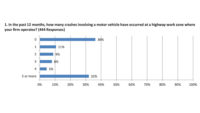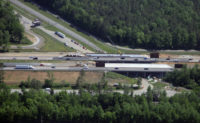Current highway work zone safeguards may no longer be sufficient to protect crews from aggressive and distracted drivers, according to a new Associated General Contractors of America survey. That trend heightens the potential for incidents such as the March 22 crash that claimed the lives of six crew members along I-695 in Baltimore, Md.
Nearly all of the more than 900 highway construction firms surveyed by AGC and industry software developer HCSS reported that work zones are either as dangerous, or more dangerous, than they were a year ago. More than 55% of respondents had experienced work zone crashes during the past 12 months, with 28% recording incidents that resulted in injury to construction workers and 8% reporting events that caused worker fatalities.
Motorists and passengers are even more vulnerable to injury and death from work zone crashes, the survey added, at a rate more than double that of construction workers.
AGC chief economist and survey author Ken Simonson told a media briefing that cellphones and other device-related distractions are also causing many motorists to miss or ignore signage and other work zone alerts set out by the U.S Transportation Dept. Manual on Uniform Traffic Control Devices.
While survey respondents said increased police presence and greater separation between work zones and active traffic lanes could help enhance safety, Simonson noted that “police departments don’t see work zone enforcement as a priority.” He added that local transportation officials are unwilling to create new congestion headaches with additional lane closures.
AGC says that while 25 states are allowed to use some form of automated speed camera and ticketing technology in highway work zones, their reach and penalties are limited. AGC says In Maryland there are only a handful of cameras available for use statewide, while the maximum penalty for work zone speeding is only $75.
“Nobody should die because our laws fail to penalize unsafe operations in work zones in the same way they punish drunk driving and stigmatize not using a seat belt,” Simonson said.
Aftermath of a tragedy
While the number of contractors reporting work zone crashes is lower than in AGC’s 2022 work zone survey, the consequences have become more dramatic, the association says. Video of the Baltimore incident showed a collision between two speeding cars, sending one vehicle through an opening in work zone concrete barriers located along the left shoulder of northbound I-695.
In its initial findings, the National Transportation Safety Board reported that both cars were traveling in “excess” of the posted 55-mph speed limit “and greater than the speed of the adjacent traffic.” With its crash investigation ongoing, it will likely be several months before the agency determines a probable cause and issues recommendations.
Maryland recently formed a Work Zone Safety Group to explore ways to protect both construction workers and motorists. Chaired by Lt. Gov. Aruna Miller, a former transportation engineer, the group is scheduled to deliver findings this fall.
More effective motorist education efforts will also enhance work zone safety, AGC says, citing Oklahoma’s first-in-the-nation requirement for successful completion of a work zone safety course as a precondition to obtain a driver’s license.
A study underway at the University of Memphis Center for Transportation Innovations in Education and Research is evaluating various work zone control and enforcement strategies for motorists, to determine the most effective mix of measures.





Post a comment to this article
Report Abusive Comment